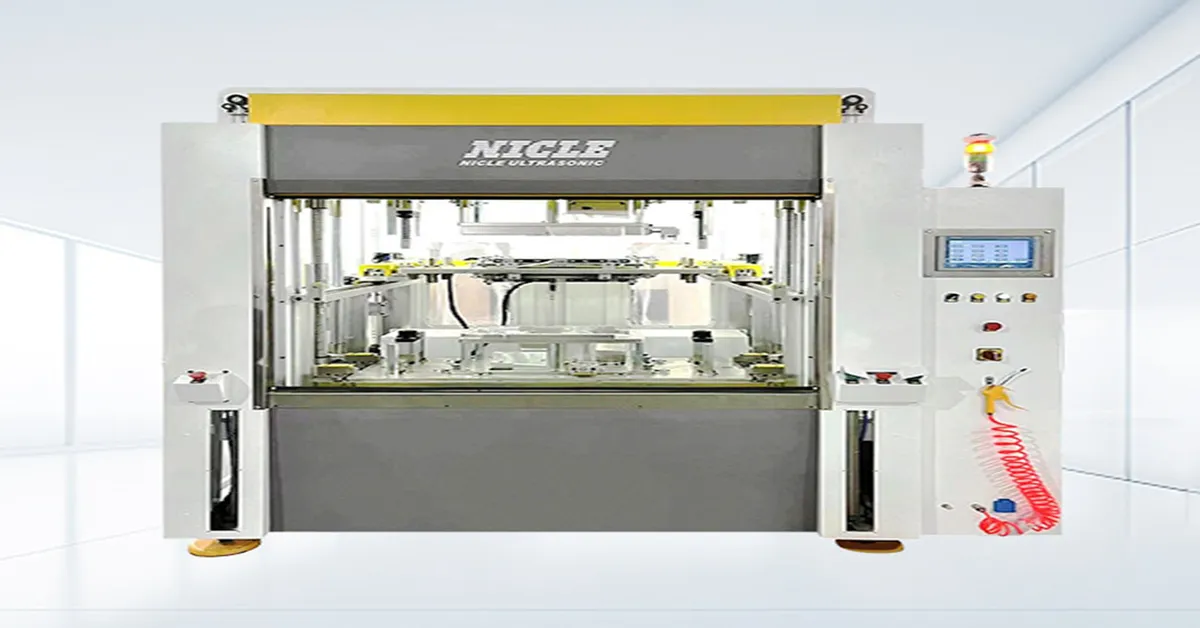Plastic hot plate welding is a critical process for joining thermoplastic materials, ensuring strong, reliable bonds in various industrial applications.
This article provides an in-depth exploration of the process, underlying mechanisms, and factors influencing the success of hot plate welding of plastics.
The Hot Plate Welding Process
The process of plastic hot plate welding involves three distinct phases: heating, transfer, and joining. Each stage is vital for achieving high-quality results and a strong bond.
- Heating Phase:
During this phase, the thermoplastic parts are pressed against a heated platen, known as a hot plate. This platen is often part of a hot plate plastic welding machine, designed to uniformly heat the surfaces of the materials.
The temperature of the plate typically ranges from 180°C to 300°C, depending on the plastic type. Prolonged or uneven heating can damage the material, emphasizing the need for precise control.
- Transfer Phase:
After achieving sufficient melting, the parts are separated from the hot plate. This step is critical to maintaining the integrity of the molten surfaces.
Alignment is essential in this phase, as improper positioning can lead to defects in the weld and impact joint strength.
- Joining Phase:
The softened parts are pressed together under a specific pressure to facilitate bonding. Cooling occurs under consistent pressure to ensure the joint solidifies without defects.
This step ensures molecular chains from both surfaces intermingle, creating a bond that can withstand mechanical stress.
Principles of Heat Transfer in Hot Plate Welding
Heat transfer is at the core of hot plate plastic welding. The quality and efficiency of the weld depend on how effectively heat is conducted from the hot plate to the plastic surfaces.
- Thermal Conductivity:
The thermal properties of different plastics influence how they absorb and transfer heat. High thermal conductivity materials heat up faster but may require more precise control to avoid degradation.
For example, materials like polypropylene and polycarbonate demand specific heat management to ensure uniform melting. - Temperature Uniformity:
The platen in a hot plate on a welding plastic machine must maintain a consistent temperature across its surface. Temperature variations can lead to uneven melting, weakening the joint.
Advanced systems often include sensors to monitor and maintain consistent heat distribution. - Heat Exposure Duration:
The time the plastic parts remain in contact with the heated platen is crucial. Insufficient exposure results in weak bonds, while excessive exposure can degrade the material or cause sagging.
Optimal timing varies based on material type, part geometry, and desired bond strength.
Material Flow and Bonding Mechanism
The success of hot plate welding of plastic parts relies on proper material flow and bonding. When the plastic reaches its molten state, it becomes pliable, allowing molecular chains from both parts to interact.
- Melt Flow Index (MFI):
Plastics with an appropriate MFI ensure that the molten material flows adequately during the joining phase. This ensures a strong and consistent bond across the joint area.
High-MFI materials may flow too easily, while low-MFI materials may resist flow, requiring careful parameter adjustments. - Pressure Application:
Uniform pressure is applied during the joining phase to ensure the molten plastic spreads evenly. This eliminates voids or air pockets that can compromise bond strength.
Excessive pressure can force the material out of the joint area, weakening the bond. - Surface Compatibility:
For effective bonding, the materials must have compatible chemical properties. Incompatible plastics may not form strong molecular interactions, leading to weak joints.
Key Advantages of Hot Plate Welding
Plastic hot plate welding offers several advantages over other joining methods, making it a preferred choice in many industries. These benefits highlight its versatility and reliability.
- High Bond Strength:
The joints formed are often as strong as or stronger than the original material. This is crucial in applications where structural integrity is non-negotiable, such as in automotive or aerospace components. - Adaptability:
The process can be tailored to different part geometries, material types, and production volumes. This flexibility makes it suitable for both intricate designs and large-scale manufacturing. - Automation Capability:
Using a hot plate plastic welding machine, manufacturers can automate the process to achieve consistent results. Automation reduces human error and increases efficiency in high-volume production. - Eco-Friendly:
Unlike adhesives or mechanical fasteners, hot plate welding of plastics does not involve harmful chemicals or additional materials. This reduces waste and environmental impact.
Common Applications
The versatility of hot plate plastic welding makes it indispensable in numerous industries. Below are some examples of its widespread use:
- Automotive Industry:
Components like air intake manifolds, fluid reservoirs, and interior panels are often joined using hot plate welding of plastic parts. These parts must withstand extreme conditions, making this process ideal for ensuring durability. - Medical Devices:
Devices such as surgical instruments, diagnostic equipment, and fluid delivery systems require precise and sterile bonds. Plastic hot plate welding meets the high cleanliness and precision standards required in this sector. - Consumer Electronics:
The structural components of gadgets, such as battery casings and enclosures, rely on this process. Hot plate welding of plastics ensures strong bonds while maintaining aesthetic appeal. - Appliances:
Water tanks, handles, and control panels in household appliances are commonly assembled using plastic hot plate welding. This provides durability and leak-proof seals.
Challenges and Limitations
Despite its numerous benefits, hot plate welding of plastics has some challenges that manufacturers must address to optimize the process.
- Energy Consumption:
Heating large plates or maintaining high temperatures in a hot plate plastic welding machine can consume significant energy. Modern systems are adopting energy-efficient heating elements to mitigate this issue. - Cycle Time:
The sequential phases of heating, transfer, and joining can lead to longer cycle times compared to other methods. Innovations in heating technology and automation are helping reduce these times. - Material Limitations:
Not all plastics are compatible with hot plate welding. Incompatible materials may require additional processes or alternative welding methods. - Surface Degradation:
Prolonged heating or excessive temperature can degrade the material’s surface, reducing the joint’s aesthetic and mechanical properties. Precise control over process parameters is essential to prevent this.
Advancements in Hot Plate Welding Technology
Continuous innovation has led to significant improvements in hot plate welding systems. These advancements address traditional challenges and enhance the process’s capabilities.
- Infrared Heating:
Infrared-assisted systems provide targeted heating, reducing energy consumption and cycle time. This technology also minimizes heat exposure to non-weld areas, improving efficiency. - Smart Controls:
Modern machines incorporate sensors and AI-driven control systems to monitor parameters in real time. These systems maintain consistent temperature and pressure, reducing defects. - Robotic Integration:
Robotic systems enhance precision in handling and aligning parts during plastic hot plate welding. Automation improves consistency and throughput in large-scale production environments. - Environmentally Conscious Designs:
Eco-friendly machines now include features like energy recovery systems and reduced emissions, aligning with sustainability goals in manufacturing.
Conclusion
Plastic hot plate welding is vital for assembling thermoplastic parts, offering strong, reliable bonds and versatility. Its ability to join materials without extra components makes it essential for high-precision industries.
With advancements like infrared heating and automated welding plastic machines, the process is becoming more efficient and sustainable, ensuring its continued importance in modern manufacturing.







